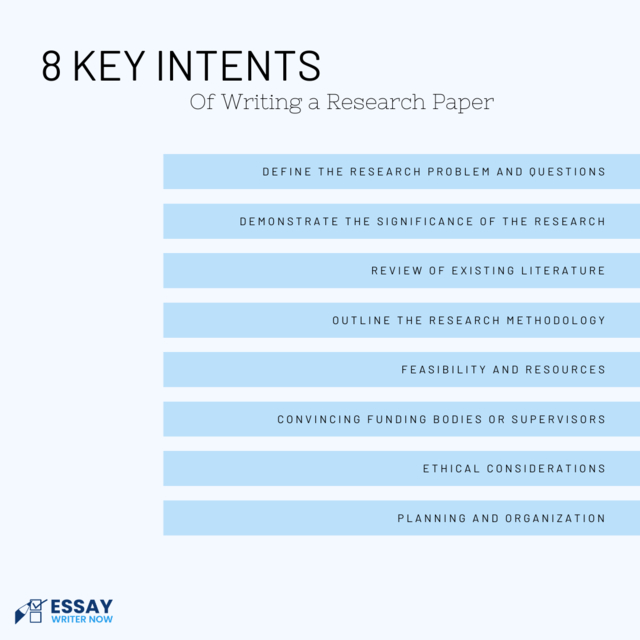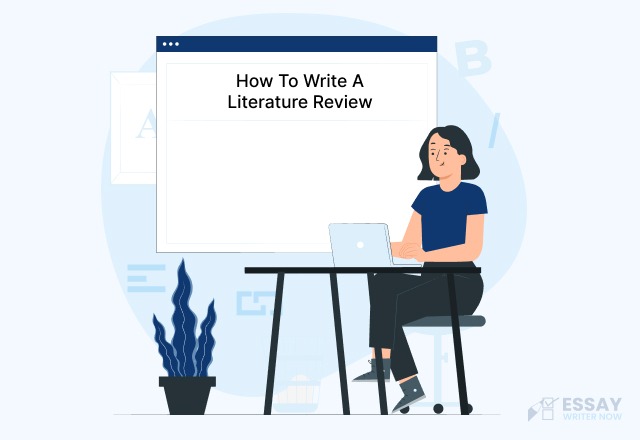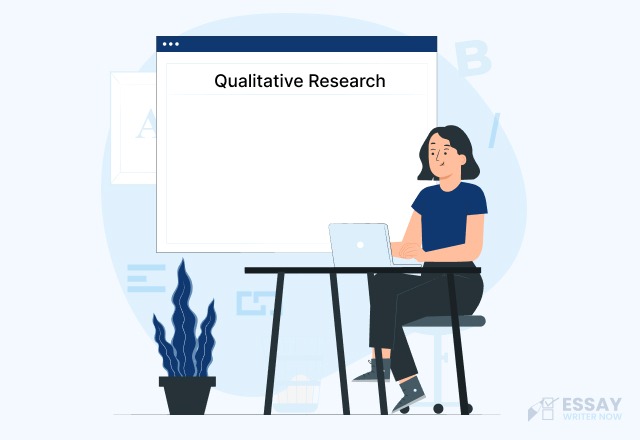Research Proposal Definition
A research proposal is a detailed plan outlining the intended study, including its objectives, methodology, and significance. It serves as a blueprint guiding the research process and as a tool for communicating the research plan to stakeholders, such as funding agencies, academic committees, or supervisors.
The proposal typically begins with an introduction that presents the research problem, its background, and its importance. This section aims to justify the need for the study by highlighting gaps in existing knowledge or practical issues that the research aims to address.
A well-defined research hypothesis or question is central to a research proposal. This component specifies what the research seeks to investigate or test, providing a clear focus for the study. The question or hypothesis should be specific, measurable, and feasible within the proposed timeframe and resources.
Why Students Have to Write a Research Proposal?
Writing a research proposal is a critical exercise for students, serving multiple important purposes in their academic and professional development. Here are some of the reasons:
- Writing a research proposal is crucial for students as it hones their ability to articulate and refine their research ideas.
- A research proposal enhances college students' research skills.
- Writing a research proposal encourages organizational and planning abilities. Students must outline a detailed research methodology, including data collection and analysis strategies, timelines, and budgets
- A well-crafted research proposal is often a prerequisite for obtaining funding, approval, or support from committees By improving their proposal writing skills, students enhance their ability to secure necessary resources and endorsements.
- The process of writing a research proposal fosters critical thinking and problem-solving skills.
- This not only prepares them for actual research but also cultivates a mindset geared toward proactive and strategic thinking.
Research Proposal Structure
Here is a sample structure for a research proposal:
1. Title Page
2. Abstract A concise summary of the research proposal, including the research question, methodology, and expected outcomes. 3. Introduction
4. Literature Review
5. Research Methodology
6. Expected Results
7. Timeline
8. Budget (if applicable)
9. References
10. Appendices (if applicable)
|
How to Write a Research Proposal?
Here’s a comprehensive guide to help you write an effective research proposal:
Title
The title of a research proposal should be clear, concise, and informative, giving the reader an immediate understanding of the research topic. It should reflect the main objective of the study and include keywords relevant to the research area.
Example:
| "Evaluating the Impact of Online Learning on High School Students' Academic Performance During the COVID-19 Pandemic" |
Abstract
The abstract is a brief summary of the research proposal, typically around 250 words. It should provide an overview of the research question, objectives, methodology, and expected outcomes. The abstract helps readers quickly grasp the essence of the proposal.
Example:
| This research proposal aims to evaluate the impact of online learning on high school students' academic performance during the COVID-19 pandemic. The study will examine how the shift from traditional classroom settings to online platforms has affected students' learning outcomes, engagement, and overall academic performance. Using a mixed-methods approach, the research will collect quantitative data through standardized test scores and qualitative data through student and teacher interviews. The expected outcome is to identify key factors that influence academic performance in an online learning environment and provide recommendations for improving online education strategies. |
Introduction
The introduction sets the stage for the research by providing background information on the topic, highlighting the significance of the study, and stating the research problem. It should present the context, justify the need for the research, and articulate the main objectives clearly.
Example:
| The COVID-19 pandemic has drastically altered the educational landscape, with schools worldwide transitioning to online learning to mitigate the spread of the virus. This sudden shift has raised concerns about the effectiveness of online learning compared to traditional classroom instruction. This study seeks to explore these concerns by evaluating the impact of online learning on high school students' academic performance. The research will provide valuable insights into the challenges and opportunities presented by online education and contribute to the development of more effective teaching strategies in the digital age. |
Literature Review
A literature review surveys existing research related to the proposed study. It identifies gaps in the current knowledge, demonstrates the researcher's understanding of the field, and establishes a foundation for the proposed research. This section should critically analyze previous studies and highlight how the proposed research will contribute to the field.
Example:
The literature on online learning and academic performance is extensive, with studies indicating both positive and negative outcomes. Previous research has shown that while online learning offers flexibility and access to a wide range of resources, it also presents challenges such as reduced student engagement and difficulties in maintaining discipline. Studies by Smith (2020) and Jones (2021) highlight the importance of effective online teaching practices and student support systems. However, gaps remain in understanding how these factors specifically affect high school students during prolonged periods of online learning. This study aims to fill these gaps by providing a comprehensive analysis of the current situation. |
Research Questions or Hypotheses
This section outlines the specific research questions or hypotheses that the study aims to address. They should be clear, focused, and researchable, guiding the direction of the study and providing a framework for data collection and analysis.
Example:
|
Methodology
The methodology section details the research design and methods to be used for data collection and analysis. It should include descriptions of the research approach (qualitative, quantitative, or mixed methods), sampling procedures, data collection instruments, and data analysis techniques. This section ensures the research is feasible and scientifically sound.
Example:
| This study will employ a mixed-methods research design, combining quantitative and qualitative approaches. The quantitative component will involve analyzing standardized test scores of high school students before and during the online learning period. The qualitative component will include semi-structured interviews with students and teachers to gather in-depth insights into their experiences and perceptions. A purposive sampling technique will be used to select participants from diverse backgrounds to ensure a comprehensive understanding of the impact of online learning. |
Significance and Implications
This section discusses the potential impact of the research findings on the field of study, policy, practice, or further research. It should highlight how the study will contribute to knowledge, address specific problems, or provide practical solutions.
Example:
| The findings of this study will provide valuable insights into the effectiveness of online learning in high school education. By identifying the key factors that influence academic performance, the research will contribute to the development of more effective online teaching strategies and support systems. The study's implications extend to educational policymakers, school administrators, and teachers, providing evidence-based recommendations for improving online learning practices and enhancing student outcomes in future educational disruptions. |
Timeline
A timeline provides a detailed schedule of the research activities, outlining when each phase of the study will be completed. It helps demonstrate the feasibility of the project within the proposed time frame and ensures that the research plan is well-organized.
Example:
Month 1-2: Literature review and development of research instruments Month 3-4: Data collection (quantitative and qualitative) Month 5-6: Data analysis and interpretation Month 7: Drafting the research report Month 8: Review and finalization of the report Month 9: Submission and dissemination of findings |
Budget
The budget outlines the financial requirements of the research, including costs for personnel, equipment, materials, travel, and other expenses. It should be detailed and justified, showing how funds will be allocated to support the research activities.
Example:
Personnel: $5,000 (research assistants, data analysts) Equipment: $2,000 (laptops, recording devices) Materials: $1,000 (survey tools, software licenses) Travel: $1,500 (interviews, site visits) Miscellaneous: $500 (printing, office supplies) Total: $10,000 |
References
The references section lists all the sources cited in the proposal, following a specific citation style (e.g., APA, MLA). This demonstrates the researcher's engagement with existing literature and provides a basis for further reading.
Example:
Smith, J. (2020). Online Learning in the Age of COVID-19: Challenges and Opportunities. Journal of Educational Technology, 15(2), 123-135. Jones, A. (2021). Student Engagement in Virtual Classrooms: A Comparative Study. Educational Research Review, 20(3), 89-102. |
Appendices
Appendices include supplementary materials that support the proposal but are not essential to its main text. These might include survey instruments, consent forms, detailed tables, or additional data. Appendices provide additional context and resources without cluttering the main body of the proposal.
Example:
| Appendix A: Survey Instrument for Students Appendix B: Interview Guide for Teachers Appendix C: Consent Forms Appendix D: Additional Data Tables |
Research Proposal Examples
Following are some examples of different types of research proposals:
What is the Intent of a Research Proposal?

A research proposal serves several critical purposes and intentions, which are essential for both the researcher and the audience evaluating the proposal.
Here’s a detailed discussion of the key intents of a research proposal:
Define the Research Problem and Questions
The primary intent of a research proposal is to clearly define the research problem and articulate the research questions or hypotheses that will guide the investigation. This involves:
- Identifying a Gap: Highlighting the gap in existing knowledge or understanding that the research aims to fill.
- Specificity: Providing specific, focused questions or hypotheses that the research will address.
Demonstrate the Significance of the Research
A research proposal aims to justify the importance of the study. This involves:
- Contextualizing the Problem: Explaining how the research fits into the broader field and why it is significant.
- Potential Impact: Describing the potential contributions of the research to knowledge, practice, policy, or society.
Review of Existing Literature
The proposal should demonstrate the researcher's familiarity with the existing literature and how their research will build on or diverge from previous work. This includes:
- Literature Review: Summarizing relevant studies and theoretical frameworks.
- Positioning the Research: Showing how the proposed study relates to and advances current knowledge.
Outline the Research Methodology
A crucial intent of the proposal is to outline the methodology, detailing how the research will be conducted. This includes:
- Research Design: Describing the overall approach (e.g., qualitative, quantitative, mixed methods).
- Data Collection: Explaining how data will be gathered (e.g., surveys, experiments, interviews).
- Data Analysis: Outlining the methods for analyzing the data.
Feasibility and Resources
The proposal should demonstrate that the research is feasible within the given constraints of time, resources, and skills. This involves:
- Timeline: Providing a realistic timeline for the research activities.
- Budget: Outlining the expected costs and funding requirements.
- Resources and Support: Identifying the necessary resources (e.g., equipment, access to data) and any institutional support.
Convincing Funding Bodies or Supervisors
For many researchers, an important intent of the research discovery proposal is to secure funding or approval from supervisors or committees. This involves:
- Persuasion: Making a compelling case for why the research should be supported.
- Clarity and Precision: Ensuring the proposal is clear, precise, and free of errors, demonstrating the researcher's competence and reliability.
Planning and Organization
Finally, the process of writing a research proposal helps the researcher to plan and organize their thoughts and activities. This involves:
- Strategic Planning: Thinking through all aspects of the research in detail.
- Structured Approach: Organizing the research activities in a logical, coherent manner.
Mistakes to Avoid While Writing Your Research Proposal

Here are some common mistakes that students make but need to avoid:
Lack of Clear Research Questions or Hypotheses
Failing to clearly define your research questions or hypotheses can make your proposal seem unfocused. Ensure your questions are specific, researchable, and relevant.
Inadequate Literature Review
A weak literature review that does not cover key theories, concepts, and research findings can undermine the credibility of your proposal. Make sure to include a thorough review that highlights gaps your research will address.
Poorly Defined Scope and Objectives
Proposals that are too broad or too narrow can be problematic. Clearly define the scope of your research and ensure your objectives are achievable within the given timeframe and resources.
Unclear Research Methodology
Not providing a detailed and justified methodology can raise questions about the feasibility and reliability of your research. Be explicit about your methods, tools, data collection, and analysis techniques.
Ignoring Ethical Considerations
Overlooking ethical issues can lead to the rejection of your proposal. Address potential ethical concerns and how you plan to mitigate them, including informed consent and confidentiality.
Insufficient Justification of the Research
Failing to explain the significance and impact of your research can make it seem unimportant. Justify the relevance and potential contributions of your study to the field.
Budget Miscalculations
Underestimating or overestimating your budget can cause problems. Provide a detailed and realistic budget, with justifications for each expense.
Weak Abstract
The abstract is often the first part that reviewers read. A poorly written abstract can lead to a negative first impression. Ensure it is concise, clear, and compelling.
Inconsistent Formatting and Presentation
Submitting a proposal with inconsistent formatting, typos, or grammatical errors can detract from your professionalism. Follow the required format and proofread your document thoroughly.
Lack of Clarity and Coherence
Proposals that are hard to follow can confuse reviewers. Ensure your writing is clear, logical, and well-organized, with a coherent narrative flow.
Ignoring Feedback and Guidelines
Not adhering to the guidelines provided by the funding body or failing to incorporate feedback from peers can result in rejection. Follow all instructions carefully and seek feedback before submission.
Overloading with Technical Jargon
Using too much technical jargon can alienate reviewers who are not experts in your specific area. Write in a way that is accessible to a broader audience.
Research Proposal Topics
Following are some interesting research proposal topics:
- Evaluation of investment strategies
- The margin financing differences from one country to another
- Analyze tax scheme of a country
- Managing stressed assets
- How to manage a team effectively?
- How to lead a team of different people?
- How does brand advertising impact political campaigns?
- How does social media affect consumers’ behavior?
- Marketing teams and their leadership
- Search engines’ importance in e-commerce
- How does social media impact buying choices of customers?
- The involvement of customers in developing a new product
In conclusion, mastering the art of writing a compelling research proposal is essential for securing admission or scholarships in academic programs. A well-structured proposal not only showcases your understanding of the research topic but also demonstrates your ability to contribute meaningfully to your chosen field.
Remember, a strong research proposal sets the foundation for your academic journey and opens doors to numerous opportunities.












